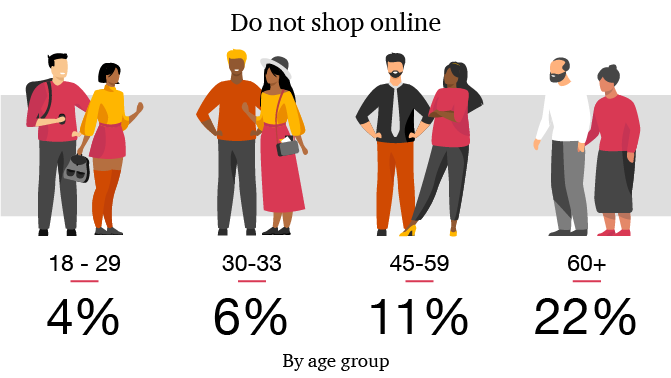Online shopping had already been gaining momentum even before the pandemic hit. With the social distancing measures required for the health and safety of shoppers, this trend was further accelerated in the last year and a half as confirmed by our 2021 Global Consumer Insights Survey. This September, as majority of the Dutch population was vaccinated and many COVID-19 related measures were eased, PwC partnered with retail specialists Q&A Consulting to survey approximately 1,800 consumers in the Netherlands about their online shopping habits.
Findings show that online shops can further optimize this channel by aligning their propositions and offerings with their target age group. Here are highlights from our inaugural Online Shopping Consumer Survey.
Potential for online growth particularly among the elderly
Online shopping has now become commonplace; however, our survey shows that some twelve percent of respondents say that they never purchase products online. A deep dive into the data shows that age plays a significant role with only four percent of people aged eighteen to twentynine who do not shop online in comparison to 22 percent of people over 60.. In other words, more than a fifth of people in the older age group category can still be persuaded to shop online – a target group with relatively more spending power than the younger age group.


Older people less willing to share data
In order to tap into the potential of older people, ensuring that the online shop effectively reflects the target group’s preferences can make an important difference. Older people prefer to contact customer service by email or phone, whereas younger people are perfectly happy with a chat feature on the website.
The willingness to share personal information when requested also varies by generation. In the eighteen to 29 group, 67 percent of people are willing to provide data in exchange for personalised offers, compared to just 32 percent of those over sixty. Irrespective of age, a majority of people surveyed want to receive something in exchange for their data: 59 percent expect free or low-cost delivery and 54 percent want exclusive discounts when they create a webshop account.
Online grocery shopping still has great potential
In our Global Consumer Insights Survey 2021, 29 percent of respondents said that they started doing more online grocery shopping during the COVID-19 pandemic. Some 37 percent of respondents now occasionally do their grocery shopping online. This percentage is greater for respondents living in more urban areas: 41 percent of respondents in urban areas compared to 31 percent of respondents in non-urban areas. The greatest increase in online grocery shopping can be achieved in the 45 and older age group category. More than half (54 percent) of people aged thirty to 44 already shop for groceries online. In response to their family lives (hectic or otherwise), many of these respondents have opted to swap the physical shopping trolley for one on a screen.

Door-to-door flyers remain popular, as does Facebook
Which media channels can online retailers turn to in order to most effectively reach potential customers? The survey shows that 22 percent of respondents are influenced by door-to-door flyers. This influence of unaddressed advertising applies across all age categories. The differences between age groups are more visible in other media channels. Young people are more likely to be tempted to make purchases by social media, whereas older consumers tend to respond more readily to email. Of all social media, Facebook continues to have the greatest influence in general, although it is worthwhile adapting the choice of channel to match the age group: the easiest way to reach respondents aged eighteen to 29 is via Instagram (44 percent), followed by YouTube (29 percent) and only then by Facebook (25 percent).
Fast delivery and low prices
When asked which features of a webshop consumers value most, respondents cited low prices, free delivery and fast delivery. Other areas in which retailers often invest are seen as less important, including the presence of a quality certification or seal (eleven percent) and the possibility to read or write reviews (nineteen percent).


Physical stores matters, especially for clothing and shoes
How important is a physical store for online sales? Some 23 percent of respondents have a preference for webshops that also have a high-street presence. Respondents see a physical store as being particularly important for the online purchase of clothing and shoes, electronics and household items. On the other hand, having a physical store as a collection point for orders is not proving popular – only fifteen percent prefer this for their deliveries. If respondents are not at home, they prefer to have online goods delivered to their neighbours.
Young people most willing to pay for fast delivery
Order now for delivery tomorrow, today or even in ten minutes’ time: retailers use the speed of delivery as a way to tempt customers. But are consumers actually willing to pay more for faster delivery? For the majority of respondents, this is asking too much, although the survey shows that the appeal of paying for faster delivery increases the younger the consumer is. For an order worth up to ten euros, 37 percent of those aged eighteen to 29 are willing to pay more, compared to fourteen percent of people over the age of sixty. For an order worth up to 250 euros, 53 percent of those aged eighteen to 29 are willing to pay more, compared to 25 percent of people over the age of sixty.

This research is in collaboration with retail experts Q&A.

Contact us
















